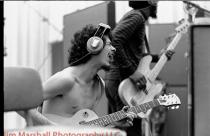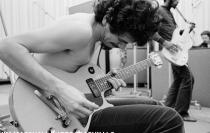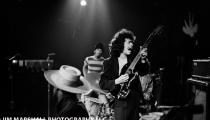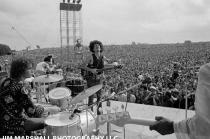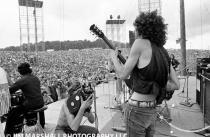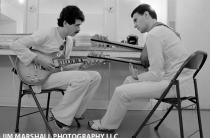I’m rounding up our final Carlos Santana-centric blog this month focusing on the skill that got him his first notice, his riveting, instantly recognizable guitar playing and improvising. One of the many things that distinguished Jim’s talent as a photographer, especially in his early years, was his extraordinary knack for recognizing talent very early, gaining the trust of those talented artists and musicians, and forging lifelong connections and collaborations with them. As I’ve pointed out time and again, these types of connections allowed Jim to do what he did best: observe, listen and then somehow capture still images that had the impact of entire movies, what Jim used to call the “hero shots.” As near as I could tell, what he really meant by “hero” was that they were images that in some nearly mystical way made you feel something powerful. Whether it was in a loud way or a quiet way really didn’t seem to matter to Jim.
Often, it’s a well-timed whisper that gives you that life-saving smack to the solar plexus or maybe it’s that perfectly framed B/W image that comes in at the nick of time to help save your day. I like to think Carlos has the same approach to his form of creating. Here’s a nice overview by Daniel Durchholz of “Santana,” the band's original studio recording for Columbia which Jim documented so well: “By the time Santana arrived on the San Francisco scene in 1968, the Grateful Dead’s freeform antics were already legendary. But Santana was a jam band of another order -- fueled by Latin rhythms, blues, bebop, and straight-ahead rock. Having set the audience at the 1969 Woodstock festival on its collective ear, the band did the same for the nation with its self-titled debut, released later that summer. Songs such as ‘Evil Ways,’ ‘Jingo,’ and ‘Soul Sacrifice’ contain extraordinary ensemble playing, powered by percolating congas and timbales and topped by the grippingly human cry of Carlos Santana’s guitar. The 1998 reissue of the album contains three bonus tracks recorded live at Woodstock: ‘Savor,’ ‘Soul Sacrifice,’ and ‘Fried Neckbones.’ ”
The shots we’re presenting today span the first decade or two of Carlos’s musical career and do a solid job of showcasing both of these young men’s burgeoning talents ... in my opinion where Jim and Carlos are concerned it is definitely a case of “took one to know one.” Like Nobody Else ... As a guitar player, Carlos is renowned for his tone and “voice,” and as someone who sawed away mercilessly at the violin for years before I abandoned it for the acoustic guitar (sorry, Mom!), it makes a ton of sense to me to learn that Carlos initially played the violin and that his father was an accomplished violinist. His phrasing and approach still seem to have echoes of that earlier set of strings.
To me, it’s like Carlos sings through his guitar. Jim used to tell me Carlos’ approach to solos, in particular, was lyrical, I love the description above: “a grippingly human cry.” Having grown up in the San Francisco Bay Area in the ’70s, to me the Santana guitar sound and jam band format feels like it was just always there in my head, one of the first, most musical sounds I can conjure, a seminal orchestra, but I’ll leave the technical descriptions and technique depictions to the experts. For any gearheads or guitar geeks out there, here’s a decent site that gives a good overview of Carlos’ choice of guitars, amps, effects, etc. over the years.
Carlos just seemed to bring out the humanity in Jim. I have a color print of Carlos taken by Jim in the late ’80s during a formal portrait sitting, I believe, at Dennis Gray’s studio in Hunter’s Point in SF. In my print, Carlos is looking right smack into the camera with that inimitable straightforward gaze, the perfect, peaceful amount of light in his eyes. I remember Jim calling me up in NYC to say that he felt he really had finally gotten, shooting color in this stilted studio setting, a shoot that came close to feeling like what he could conjure live, in black and white. He was really proud. Another image from this shoot ran in “Not Fade Away,” but rather than staring a hole through the lens, Carlos is looking up to his right. The shot has a faraway feel and is unusual in that Jim was always, always about eye contact. This one is quieter and, really, I think I like it just a bit better. Go figure.
Jim’s caption reads: “Carlos Santana in my friend’s studio in San Francisco, 1988. I go back a long way with Carlos, to the year 1965. I remember I was sitting in jail on a drug charge, and the bail bondsman who helped me get out was also the road manager for the Santana Blues Band. So he asked me to do him a favor and take a picture of the band. Since then I’ve done a couple of album covers, a lot of magazine work, and a very famous sequence of Carlos in his first recording sessions. I love the guy, and he plays the guitar like nobody else.” If you want to understand what Jim saw and heard in 1965 to make him stick with this guy through thick and thin, check out this video of “Soul Sacrifice,” the Santana band’s breakout moment at Woodstock in 1969, the day the world caught up with Jim's heroic eyes. Look close and you might see a certain photographer in the background, too. And, what better way to wrap up all this wonderful Santana-ness, than with a quote from the man himself:
“Realize that when you get older, you either get senile or become gracious. There’s no in-between. You become senile when you think the world short-changed you, or everybody wakes up to screw you. You become gracious when you realize that you have something the world needs, and people are happy to see you when you come into the room.”
- Jim Marshall Photography LLC Newsroom blog
- Log in to post comments
